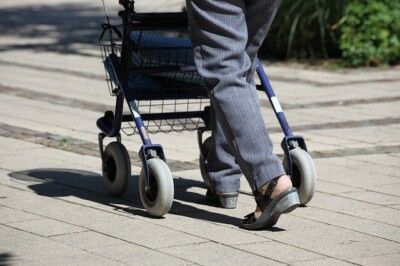The right aid for walking disability – walking aids and rollator
In the case of balance disorders or various types of walking disabilities, the rollator has long been established as an aid. This walking aid gives the user the necessary support.
Why a walking aid is useful
No matter what kind of disease it is, a walking aid can be very helpful in many cases. It gives more security when walking, protects the joints and thus protects the user from dangerous falls.
However, some people are reluctant to use a walking aid because of shame. In this case, however, you should be aware that the right walking aid or rollator can give you a bit more freedom and independence again.
This increases the quality of life of the person affected in the long term.
The rollator, an aid for many cases
The reasons for using a walking aid can be very diverse. Age is not always a factor here, as disabilities can affect younger people as well. Indications for the use of a walker or the use of a rollator can be, among others:
- Rheumatism,
- Osteoarthritis,
- multiple sclerosis,
- the consequences of a stroke,
- a hip condition,
- general balance problems,
- relearning to walk after an accident as part of a rehabilitation measure.
Not every aid is suitable for everyone. Therefore, if you are not quite sure, you should seek the professional advice of your family doctor, specialist or your physiotherapist before purchasing rollator & Co.
The right walking aid for every clinical picture
Walking disabilities and limitations can affect people of any age, but are more common among seniors. Depending on the diagnosis and the severity of the walking disability, the type of assistive device used may vary.
Forearm crutches
These are known to most people under the term „crutches“. They can be varied in length via a telescopic device and thus adapted to the user’s body size.
They are useful for people who need a little more support when walking and for people who are not allowed to put full weight on their legs. For example, after a hip operation, a knee condition or a broken leg.
Wheelchair
Wheelchairs are useful if there is hardly any strength left in the legs or if there is even paralysis of the extremities. This can be the case with paraplegia after an accident, nerve damage due to multiple sclerosis or after a stroke.
But severe pain from rheumatism or osteoarthritis can also make a wheelchair necessary. The type of wheelchair can be adapted to the needs of the patient.
For example, the height of the backrest, the type of armrests and the seat width can be varied. A supply with headrests or with an additional drive is also possible.
Walking stick
Meanwhile, there are also several options when it comes to choosing a walking stick. Modern walking sticks now also have a folding function and can be adjusted in height by means of a flexible telescopic rod.
Folded, they can be easily stowed in a pocket or backpack. For special needs, such as stroke patients, there are also so-called three-point canes.
These owe their name to the special construction. The sticks have not only a stick tip at the lower end, but three solid feet with rubber profile. In this way there is a much higher stability and more safety when walking.
Rollator
In many cases, a rollator can help you regain some of your independence in everyday life. The assistive device not only makes walking safer, but also has a convenient seat for resting.
An additional basket or net provides space for purchases. Different rollator manufacturers offer different models. Some are especially light and easy to store by folding up.
Walking aid on prescription
Many treatments and aids can also be financed or partially subsidized by the statutory health insurances. This also applies to rollators, wheelchairs, walking sticks or crutches.
Regardless of the type of walking aid, a prescription from the family doctor, orthopedist or neurologist is always necessary. The diagnosis and the type of remedy should be noted on it. Because only then the health insurance will cover the costs.
Many health insurance companies have contracts with medical supply stores. Thus the patient receives on prescription then an aid directly from the health insurance company supplied. If the patient wants a special model or special equipment, a higher co-payment is required by the health insurance company.
In addition, many other aids for more mobility in everyday life can also be financed by the health insurance company. This also includes: shower seats and bathing aids, commode chairs, toilet elevators and care beds. The corresponding prescription from the doctor must be submitted to the health insurance company for this purpose as well.
Conclusion
Whether wheelchair, rollator or crutches, the decision for an aid is up to you. However, these tips should make your choice a little easier.
